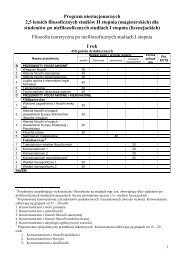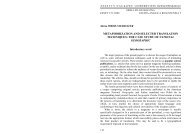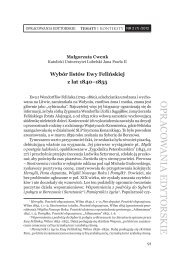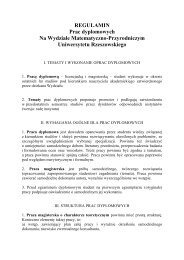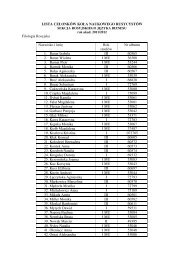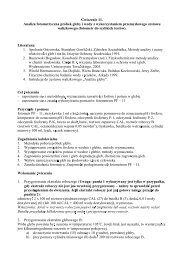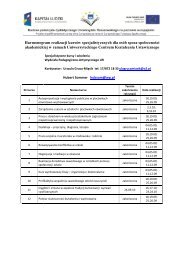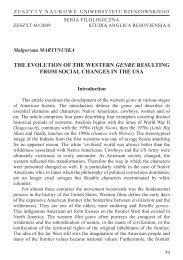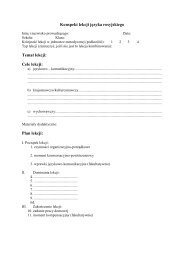<strong>quadratic</strong> <strong>equations</strong> are quite scarce <strong>in</strong> algebra education research (Kieran, 2007;Vaiyavutjamai & Clements, 2006). Therefore, this study was designed to widen theresearch consider<strong>in</strong>g students’ <strong>reason<strong>in</strong>g</strong> when engag<strong>in</strong>g <strong>in</strong> different types of<strong>quadratic</strong> <strong>equations</strong> <strong>in</strong> <strong>one</strong> <strong>unknown</strong>. In particular, this study <strong>in</strong>vestigated students’processes for solv<strong>in</strong>g <strong>quadratic</strong> <strong>equations</strong> <strong>with</strong> <strong>one</strong> <strong>unknown</strong> by us<strong>in</strong>g thefactorization technique.The f<strong>in</strong>d<strong>in</strong>gs of this study may provide teachers <strong>with</strong> <strong>in</strong>sight <strong>in</strong>to the <strong>reason<strong>in</strong>g</strong> thatleads to the common mistakes that students make while solv<strong>in</strong>g <strong>quadratic</strong> <strong>equations</strong>,and hence guide them <strong>in</strong> creat<strong>in</strong>g a more efficient pedagogical design for teach<strong>in</strong>ghow to solve <strong>quadratic</strong>s.Challenges faced by Students <strong>in</strong> Solv<strong>in</strong>g Quadratic EquationsAccord<strong>in</strong>g to Kotsopoulos (2007), for many secondary school students, solv<strong>in</strong>g<strong>quadratic</strong> <strong>equations</strong> is <strong>one</strong> of the most conceptually challeng<strong>in</strong>g aspects <strong>in</strong> the highschool curriculum. She <strong>in</strong>dicated that many students encounter difficulties recall<strong>in</strong>gma<strong>in</strong> multiplication facts, which directly <strong>in</strong>fluences their ability to engage <strong>in</strong><strong>quadratic</strong>s. And, s<strong>in</strong>ce the factorization technique of solv<strong>in</strong>g <strong>quadratic</strong> <strong>equations</strong>requires students to be able to rapidly f<strong>in</strong>d factors, factor<strong>in</strong>g simple <strong>quadratic</strong>s (i.e.,x 2 +bx+c=0 where b, c R) become a quite challenge, while non-simple <strong>quadratic</strong>s(i.e., ax 2 +bx+c=0 a, b, c R and a≠1) become nearly impossible. Moreover,students encounter crucial difficulties <strong>in</strong> factor<strong>in</strong>g <strong>quadratic</strong> <strong>equations</strong> if they arepresented <strong>in</strong> non-standard forms. For example, factor<strong>in</strong>g x 2 +3x+1=x+4 ischalleng<strong>in</strong>g for students, s<strong>in</strong>ce the equation is not presented <strong>in</strong> standard form(Kotsopoulos, 2007). Similarly, Bossè and Nandakumar (2005) stated that thefactor<strong>in</strong>g techniques for solv<strong>in</strong>g <strong>quadratic</strong> <strong>equations</strong> are problematic for students.They <strong>in</strong>dicated that students can f<strong>in</strong>d factor<strong>in</strong>g the <strong>quadratic</strong>s considerably morecomplicated when the lead<strong>in</strong>g coefficient or constant <strong>in</strong> the <strong>quadratic</strong> has many pairsof possible factors.Skemp’s (1976) description of <strong>in</strong>strumental and relational understand<strong>in</strong>g can be usedas a framework to discuss the difficulties students have <strong>with</strong> factor<strong>in</strong>g <strong>quadratic</strong><strong>equations</strong>. While an <strong>in</strong>strumental understand<strong>in</strong>g of factoriz<strong>in</strong>g <strong>quadratic</strong> <strong>equations</strong><strong>with</strong> <strong>one</strong> <strong>unknown</strong> requires memoriz<strong>in</strong>g rules for <strong>equations</strong> presented <strong>in</strong> particularstructures, relational understand<strong>in</strong>g enables students to apply these rules to differentstructures easily (Reason, 2003). That is, when students have relationalunderstand<strong>in</strong>g, they can transfer knowledge of both what rules (and formulas) workedand why they worked from <strong>one</strong> situation to another (Skemp, 2002).Lima (2008) found that students may perceive <strong>quadratic</strong> <strong>equations</strong> just like they docalculations. S<strong>in</strong>ce they focus mostly on the symbols used to perform operations, theymay not be aware of the concepts that are <strong>in</strong>volved. Vaiyavutjamai and Clements(2006) expla<strong>in</strong> that students’ difficulties <strong>with</strong> <strong>quadratic</strong> <strong>equations</strong> arise from the lackof both <strong>in</strong>strumental and relational understand<strong>in</strong>g of the associated mathematics.They found several misconceptions regard<strong>in</strong>g variables which were obstacles to2
understand<strong>in</strong>g <strong>quadratic</strong> <strong>equations</strong>. For example, students thought that the two x’s <strong>in</strong>the equation (x-3) ∙(x-5) =0 stood for different variables, even though most of themobta<strong>in</strong>ed the correct solutions x=3 and x=5. Hence, they concluded that students’performance <strong>in</strong> that context reflect rote learn<strong>in</strong>g and a lack of relationalunderstand<strong>in</strong>g.METHODOLOGYParticipants and the InstrumentThe sample of this study consisted of 113 students <strong>in</strong> four 10 th grade classes, and thisstudy was performed <strong>in</strong> a high school <strong>in</strong> Antalya, Turkey dur<strong>in</strong>g the spr<strong>in</strong>g term2009-2010.For the purpose of the study, a questionnaire was formed by the authors s<strong>in</strong>ce no testto specifically explore students’ errors and understand<strong>in</strong>g was available. The testquestions were carefully selected from secondary mathematics textbooks and fromresearch regard<strong>in</strong>g <strong>quadratic</strong> <strong>equations</strong> (e.g., Crouse & Sloyer, 1977). All questionsused <strong>in</strong> this questionnaire were selected to measure the study objective ofdeterm<strong>in</strong><strong>in</strong>g how students “determ<strong>in</strong>e the roots and solution set of [a] <strong>quadratic</strong>equation <strong>in</strong> <strong>one</strong> <strong>unknown</strong>”. Dur<strong>in</strong>g the selection process, two mathematics educatorsand a mathematics teacher were consulted about whether the content of the selectedquestions were consistent <strong>with</strong> the objective of the test. In light of their suggestions,seven open ended question were determ<strong>in</strong>ed. Although the format of the all of thequestions was open-ended, they varied <strong>in</strong> type so as to be consistent <strong>with</strong> theobjective of the study. Questions 1 to 4 were <strong>in</strong> the standard format <strong>in</strong> which studentswere expected to “f<strong>in</strong>d the solution set of the given <strong>quadratic</strong> equation”. Thesequestions were based on procedural skills, and they were mostly used to detectstudents’ procedural abilities <strong>in</strong> solv<strong>in</strong>g <strong>quadratic</strong> <strong>equations</strong> <strong>in</strong> different structures. Onthe other hand, questions 5 to 7 <strong>in</strong>troduced a mathematical scenario that <strong>in</strong>cludedboth a <strong>quadratic</strong> equation and a solution belong<strong>in</strong>g to it. In these type of questions,students were expected to determ<strong>in</strong>e “whether the solutions [belong<strong>in</strong>g to] the<strong>equations</strong> were correct or not, and to make judgment about their decision”.Therefore, <strong>in</strong> addition to procedural skills, these questions were used to detectstudents’ understand<strong>in</strong>g of and <strong>reason<strong>in</strong>g</strong> level when deal<strong>in</strong>g <strong>with</strong> <strong>quadratic</strong><strong>equations</strong>.The mathematics teacher adm<strong>in</strong>istered the questionnaire dur<strong>in</strong>g the regular classperiod and the students were given 30 m<strong>in</strong>utes to complete it.Analysis of DataInitially, the responses given to each question were givens scores of either 1 or 0. Ascore of 1 was given for answers that were mathematically correct <strong>in</strong> terms of bothsolution process and f<strong>in</strong>al answer. A score of 0 was given for answers that were eitheromitted or <strong>in</strong>correct <strong>in</strong> terms of either solution process or f<strong>in</strong>al answer. Then, <strong>in</strong> orderto obta<strong>in</strong> a general view of the students’ performance, the percentage of correct,3




